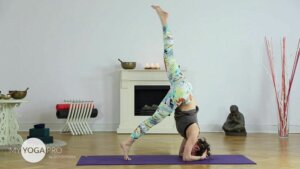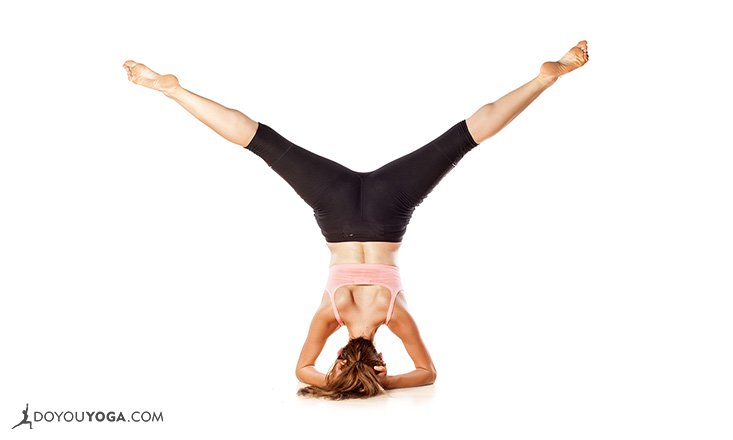Feeling groggy? Struggling with congestion? Need help refocusing? Inversions are the solution to all of these issues!
Inversions, such as headstand, forearm stand, shoulder stand and more, can improve circulation and improve health by draining lymph and resetting your nervous system. Inversions can be intimidating, so how do you get started? One great way to start practicing inversions is to get stuck into the free 30 Day Yoga Challenge! You’ll quickly get used to going upside down when you’re in a Downward Facing Dog every day!
After warming up your body with a quick practice, these 7 introductory poses will help your body prepare to be upside down!
1. Downward Facing Dog

You can try rolling forward onto the balls of your feet, shifting more of your body weight forward into your shoulders to see how strong your upper body is feeling. Pull your navel back toward your spine, engaging your core to give yourself more stability and strength in the pose. Challenge yourself to see how much power you can put into your Downward Facing Dog.
2. High Plank

Rotate the upper arms inward, bringing the elbow creases to face one another. This is a great opportunity to roll back and forth from Downward Dog into plank and back again several times, warming up your shoulder girdle muscles and your core. These are the two main muscle groups to concentrate on in preparation for shoulder stand.
3. Dolphin Plank

You can keep your palms face-down on the mat in a direct line with your elbows, or you can lace your hands together in front of you. In either case, keep your elbows shoulder-distance apart. Draw your core in towards your spine to support your lower back, trying not to sag through the lower half of the body.
In this pose, you can again try rolling forward onto the balls of your toes, making minute shifts forward and backward to challenge your shoulders, all while still pushing the mat away by extending through your shoulder joints.
4. Dolphin Pose

Your weight will start to shift more into your shoulders at this point, and you should keep the same amount of engagement in the core as you did in the previous pose—it’s easy to forget!
Refocus on your core using your breath as you walk your toes in, pulling your hip bones up to the ceiling and continuing to pull your ears away from your shoulders to avoid any collapsing in this area.
5. Headstand Prep
This pose simply builds in intensity on the previous pose, as you bring your feet as close as possible to your elbows. At this point, most of your body weight is centered over your shoulders, and this is the moment to position your head on the floor.
Interlacing your fingers on the mat in front of you, bring the crown of your head to the floor with no pressure on the crown itself. Simply make very light contact with the floor and cradle the back of your skull with your interlaced fingers.
Keeping length and strength in the neck, engage the forearms and shoulders—these two muscle groups are carrying all of your body weight. If a friend happened upon you in this pose, they would be able to easily slip their credit card between your head and the floor.
6. One-Legged Headstand

Lift one foot up as far as you can, testing out what kind of core strength will be required to lift both feet up off the ground. Switch legs back and forth until you are comfortable lifting one leg off the mat while not compromising your head and neck safety.
7. Headstand Against the Wall
 Credit: Kristin McGee
Credit: Kristin McGeeFinally, position yourself in the previous pose with your head close to a wall, so that when in one-legged headstand, your back is facing the wall. Bring one foot off the floor by drawing that knee into your chest. Do the same with the other foot, drawing that knee into your chest as well.
Both feet are now off the mat, with your forearms and shoulders bearing your body weight. Take this moment, with all of your weight consolidated into a small ball, to try and straighten out and lengthen your spine.
Then, use your core strength and breath to push one leg and then the other up into the air, letting the heels of your extended feet rest on the wall behind you for support.
Eventually, you’ll feel so secure and confident that you won’t need the wall—you will have achieved freestanding headstand!
Now, these poses aren’t meant to be done one right after the other in quick succession. Simply add them individually into your regular practices with increasing frequency and duration, and after a few weeks, your shoulders and core will be well-practiced for the strength and movement necessary for headstand.


